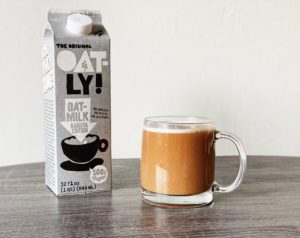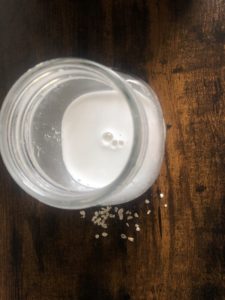In the early 2000s, when I first stopped eating meat, I immediately switched to soy milk. At the time, and also perhaps due to my geographic location, my options were limited. It was either soy or almond, and I find almond milk to be a bit watery for my liking. Later, I became concerned about the sustainability of almond cultivation. Soy, then, was the obvious answer.
While soy milk is likely a bit sweeter than dairy milk—honestly I don’t actually remember what dairy milk tastes like at this point—I quickly adapted to using it for cereal and oatmeal. When I started drinking coffee and tea some years later, I found soy milk worked well as a creamer. But as the world of plant food innovation continues to expand, I have had the pleasure of trying many plant milks out there. Hemp, rice, macadamia, coconut, pea, and within more recent years, oat milk. And wow, I fell in love.

For the past several years, I purchased one to two cartons of oat milk a week. I use it for everything! Coffee and tea creamer, cooking and baking. When I want to cut back on spending, I typically revert back to soy milk or buy whatever brand of oat milk is on sale. But, not all oat milk brands are created equally and I find I have preferences.
About a year ago, I purchased a nut milk bag from a local farmers market I visited. I largely forgot about it for months, but I knew when I bought it that it was the kind of thing I want to have around. Lately I’ve been busy and haven’t been grocery shopping as frequently. I quickly remembered the bag once I ran out of store-bought oat milk. The nut milk bag was still in its packaging in my pantry. And at least one bulk package of organic quick rolled oats is a staple in my kitchen.
I read many DIY oat milk recipes, including the one here on PD of course. During this brief exploration phase, I noticed I was feeling overwhelmed by the wealth of information out there. Are steel cut oats or quick cooking oats better? Is it best to use dates for sweetener, or maple syrup? As with all recipes, there is a lot of nuance and opinion out there.
I found the best way to get past all that was to simply start playing around.
My first attempt I used maple syrup as a sweetener. The oat milk tasted good, but the maple flavor was pronounced. I couldn’t imagine using it for mashed potatoes or curries, for example. However, it worked pretty well for coffee and smoothies. My only other complaint is, it wasn’t very thick. I favor full fat, thicker milks.
So my next attempt I used the liquid Organic Stevia from Trader Joe’s. I also doubled the amount of oats I was using, but did not double the water. And that became my standard recipe:
2 cups filtered water
3/4 cup quick rolled oats
Hefty pinch of salt
2–4 drops Trader Joe’s Organic Stevia liquid
Add to a blender and blend on low for 20–30 seconds. Strain through a nut milk bag into a glass jar.

Some recipes will tell you to squeeze the nut milk bag. Others advise against it because it can result in slimy milk. I like to use a jar with a narrow mouth that naturally works some of the excess moisture out of the bag while lifting the bag out, without having to squeeze.
Reasons you should try this:
It saves money.
I used to spend 5–8 dollars on oat/soy milk each week. That may seem trivial to some, just chump change. But think: that is at least $240/yearly I am saving by omitting that expense. Plus, think of all the packaging I am keeping out of landfills/recycling facilities.
It is zero waste.
The oat milk itself can obviously be consumed. The oats that have been blended in the bag are delicious with maple syrup or muddled fruit on them, or to use on smoothie bowls or to top smoothies. All that to say, they are yummy and can/should be consumed. I think my favorite aspect of making oat milk from scratch is being able to use every bit.
It is easy.
As long as you have a blender and a nut milk bag, this is accessible for everyone! My artisan crafted nut milk bag cost me around $5.00 at a local farmers market. Note: when shopping for your own nut milk bag, be sure to ensure that it is reusable/washable. I lay mine on the top rack of my dishwasher after giving it a thorough rinse.
There are a few downsides to DIY oat milk that I have found, so far. The first is that small batches are best. It is advised that fresh oat milk be consumed within 2–3 days, so I only make two cups at a time. But often, I end up using the entire batch between coffee, smoothies and cooking or baking. Luckily, it only takes a couple minutes to make more!
Second, the oat milk separates a lot. (I understand why plant milks aren’t sold in clear jars.) So, be sure to give it a thorough shake if you’re reaching for oat milk you made earlier on.

What do you think, will you try DIY oat milk?
Get more like this—Sign up for our daily inspirational newsletter for exclusive content!
__
Photo: Madalyn Cox via Unsplash, R. Coker




